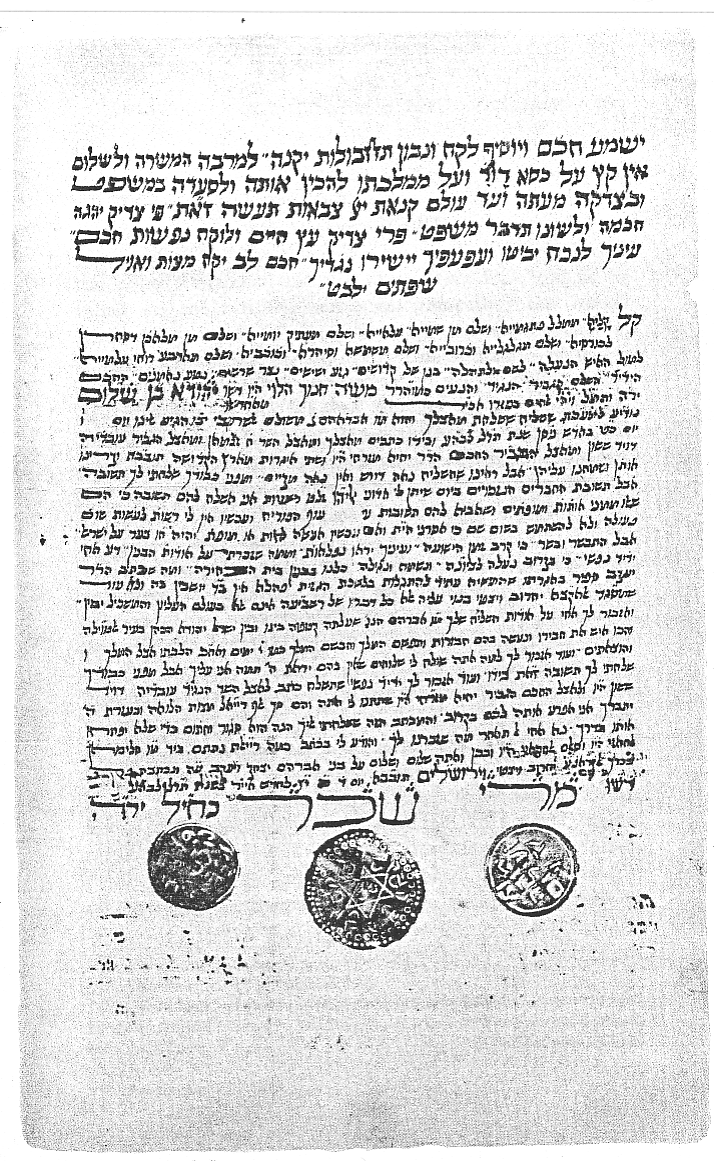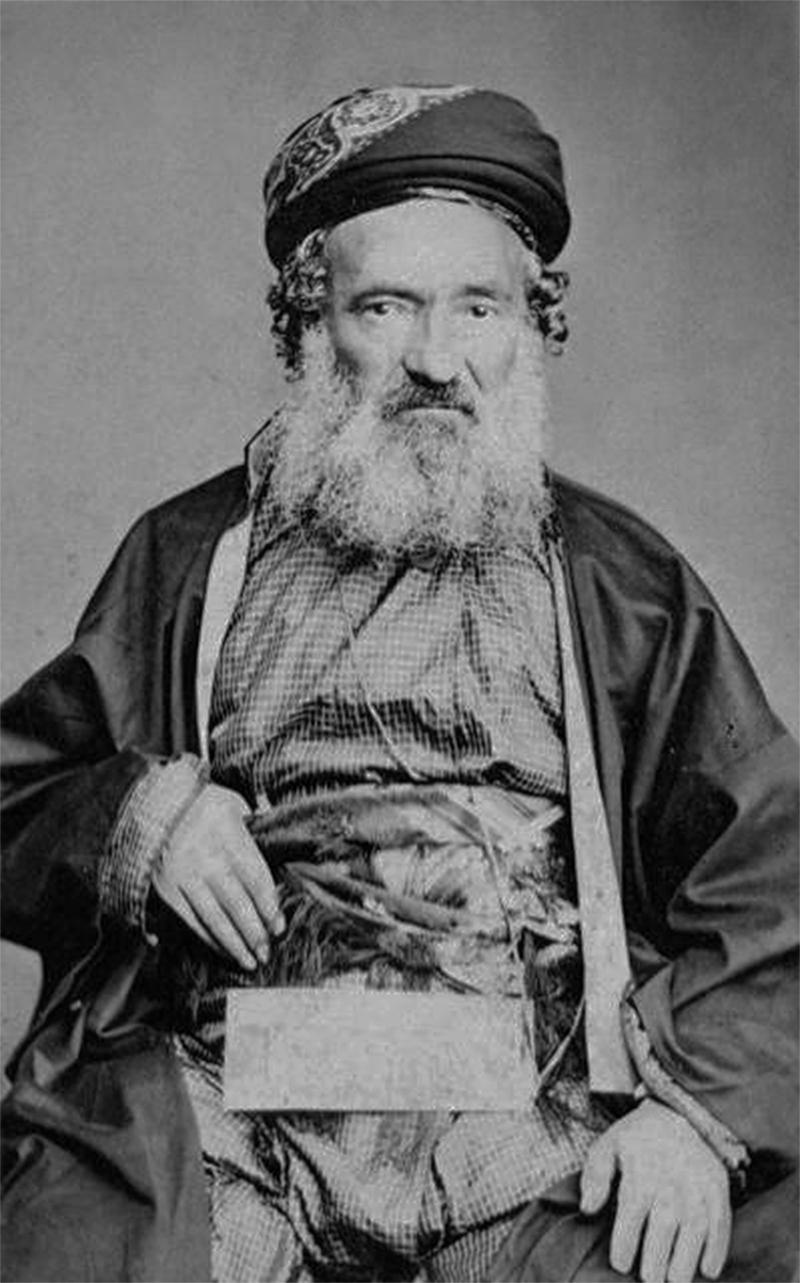|
Judah Ben Shalom
Judah ben Shalom (died ca. 1878) (Hebrew: יהודה בן שלום), also known as Mori (Master) Shooker Kohail II or Shukr Kuhayl II (Hebrew: מרי שכר כחיל), was a Yemenite messianic claimant of the mid-19th century. The rise of Shukr Kuhayl II Judah ben Shalom was either a potter or a cobbler hailing from San‘a’, Yemen, and was evidently an accomplished kabbalist . He announced to the Jews of Yemen in March 1868 that he was in fact the self-same messianic claimant known as Shukr Kuhayl I, who had been killed and decapitated by Arabs just three years prior, now resurrected by Elijah. The exact manner in which Judah ben Shalom was able to take over the identity of the deceased Shukr Kuhayl, and in so doing to completely erase his own personal history, must remain something of a mystery. The new (or ''renewed'') Shukr Kuhayl continued to preach the message of repentance that Yemenite Jews were familiar with from prior messiahs, as well as from local religious tr ... [...More Info...] [...Related Items...] OR: [Wikipedia] [Google] [Baidu] |
Amoraim
''Amoraim'' (Aramaic language, Aramaic: plural or , singular ''Amora'' or ''Amoray''; "those who say" or "those who speak over the people", or "spokesmen") refers to Jewish scholars of the period from about 200 to 500 Common Era, CE, who "said" or "told over" the teachings of the Oral Torah. They were primarily located in Babylonia and the Land of Israel. Their legal discussions and debates were eventually Codification (law), codified in the Gemara. The ''Amoraim'' followed the ''Tannaim'' in the sequence of ancient Jewish scholars. The ''Tannaim'' were direct transmitters of uncodified oral tradition; the ''Amoraim'' expounded upon and clarified the oral law after its initial codification. The Amoraic era The first Babylonian ''Amoraim'' were Abba Arika, respectfully referred to as ''Rav'', and his contemporary and frequent debate partner, Samuel of Nehardea, Shmuel. Among the earliest ''Amoraim'' in Israel were Johanan bar Nappaha and Shimon ben Lakish. Traditionally, the ... [...More Info...] [...Related Items...] OR: [Wikipedia] [Google] [Baidu] |
Zohar
The ''Zohar'' ( he, , ''Zōhar'', lit. "Splendor" or "Radiance") is a foundational work in the literature of Jewish mystical thought known as Kabbalah. It is a group of books including commentary on the mystical aspects of the Torah (the five books of Moses) and scriptural interpretations as well as material on mysticism, mythical cosmogony, and mystical psychology. The ''Zohar'' contains discussions of the nature of God, the origin and structure of the universe, the nature of souls, redemption, the relationship of Ego to Darkness and "true self" to "The Light of God". The ''Zohar'' was first publicized by Moses de León (c. 1240 – 1305 CE), who claimed it was a Tannaitic work recording the teachings of Simeon ben Yochai (). This claim is universally rejected by modern scholars, most of whom believe de León, also an infamous forger of Geonic material, wrote the book himself between 1280 and 1286. Some scholars argue that the ''Zohar'' is the work of multiple medieval author ... [...More Info...] [...Related Items...] OR: [Wikipedia] [Google] [Baidu] |
Wissenschaft Des Judentums
"''Wissenschaft des Judentums''" (Literally in German the expression means "Science of Judaism"; more recently in the US it started to be rendered as "Jewish Studies" or "Judaic Studies," a wide academic field of inquiry in American Universities) refers to a nineteenth-century movement premised on the critical investigation of Jewish literature and culture, including rabbinic literature, to analyze the origins of Jewish traditions. The ''Verein für Kultur und Wissenschaft der Juden'' The first organized attempt at developing and disseminating ''Wissenschaft des Judentums'' was the ''Verein für Kultur und Wissenschaft der Juden'' (''Society for Jewish Culture and Jewish Studies''), founded around 1819 by Eduard Gans, (a pupil of Hegel), and his associates. Other members included Heinrich Heine, Leopold Zunz, Moses Moser, and Michael Beer, (youngest brother of Meyerbeer). It was an attempt to provide a construct for the Jews as a ''Volk'' or people in their own right, independen ... [...More Info...] [...Related Items...] OR: [Wikipedia] [Google] [Baidu] |
Lubavitch Hasidism
Chabad, also known as Lubavitch, Habad and Chabad-Lubavitch (), is an Orthodox Jewish Hasidic dynasty. Chabad is one of the world's best-known Hasidic movements, particularly for its outreach activities. It is one of the largest Hasidic groups and Jewish religious organizations in the world. Unlike most Haredi groups, which are self-segregating, Chabad operates mainly in the wider world and caters to secularized Jews. Founded in 1775 by Rabbi Schneur Zalman of Liadi, the name "Chabad" () is an acronym formed from three Hebrew words— (the first three sephirot of the kabbalistic Tree of Life) (): "Wisdom, Understanding, and Knowledge"—which represent the intellectual and kabbalistic underpinnings of the movement. The name Lubavitch derives from the town in which the now-dominant line of leaders resided from 1813 to 1915. Other, non-Lubavitch scions of Chabad either disappeared or merged into the Lubavitch line. In the 1930s, the sixth Rebbe of Chabad, Rabbi Yosef Yitzchak Sc ... [...More Info...] [...Related Items...] OR: [Wikipedia] [Google] [Baidu] |
Jacob Saphir
Jacob Saphir ( he, יעקב הלוי ספיר; 1822–1886) was a 19th-century writer, ethnographer, researcher of Hebrew manuscripts, a traveler and emissary of the rabbis of Eastern European Jewish descent who settled in Jerusalem during his early life. Background Saphir was born in Ashmyany in the Russian Empire (now Belarus) and immigrated to Ottoman Palestine as a child with his family in 1832. His parents, who were from the Perushim community, settled in Safed. Within a month his father died and a year later his mother died. At the age of 12, he witnessed the attack by the Arabs of the Galilee on the Jews of Safed in the lunar month of Sivan, 1834. Due to the earthquake that occurred in Safed in 1837, he moved to Jerusalem. In 1848, he was commissioned by the Jewish community of the latter city to travel through the southern countries to collect alms for the poor of Jerusalem. In 1854 he undertook a second tour to collect funds for the construction of the Hurva Synagogue ... [...More Info...] [...Related Items...] OR: [Wikipedia] [Google] [Baidu] |
Synagogue
A synagogue, ', 'house of assembly', or ', "house of prayer"; Yiddish: ''shul'', Ladino: or ' (from synagogue); or ', "community". sometimes referred to as shul, and interchangeably used with the word temple, is a Jewish house of worship. Synagogues have a place for prayer (the main sanctuary and sometimes smaller chapels), where Jews attend religious Services or special ceremonies (including Weddings, Bar Mitzvahs or Bat Mitzvahs, Confirmations, choir performances, or even children's plays), have rooms for study, social hall(s), administrative and charitable offices, classrooms for religious school and Hebrew school, sometimes Jewish preschools, and often have many places to sit and congregate; display commemorative, historic, or modern artwork throughout; and sometimes have items of some Jewish historical significance or history about the Synagogue itself, on display. Synagogues are consecrated spaces used for the purpose of Jewish prayer, study, assembly, and r ... [...More Info...] [...Related Items...] OR: [Wikipedia] [Google] [Baidu] |
Tithe
A tithe (; from Old English: ''teogoþa'' "tenth") is a one-tenth part of something, paid as a contribution to a religious organization or compulsory tax to government. Today, tithes are normally voluntary and paid in cash or cheques or more recently via online giving, whereas historically tithes were required and paid in kind, such as agricultural produce. After the separation of church and state, church tax linked to the tax system are instead used in many countries to support their national church. Donations to the church beyond what is owed in the tithe, or by those attending a congregation who are not members or adherents, are known as offerings, and often are designated for specific purposes such as a building program, debt retirement, or mission work. Many Christian denominations hold Jesus taught that tithing must be done in conjunction with a deep concern for "justice, mercy and faithfulness" (cf. Matthew 23:23). Tithing was taught at early Christian church councils, ... [...More Info...] [...Related Items...] OR: [Wikipedia] [Google] [Baidu] |
Con-man
A confidence trick is an attempt to defraud a person or group after first gaining their trust. Confidence tricks exploit victims using their credulity, naïveté, compassion, vanity, confidence, irresponsibility, and greed. Researchers have defined confidence tricks as "a distinctive species of fraudulent conduct ..intending to further voluntary exchanges that are not mutually beneficial", as they "benefit con operators ('con men') at the expense of their victims (the 'marks')". Terminology Synonyms include con, confidence game, confidence scheme, ripoff, scam, and stratagem. The perpetrator of a confidence trick (or "con trick") is often referred to as a confidence (or "con") man, con-artist, or a "grifter". The shell game dates back at least to Ancient Greece. Samuel Thompson (1821–1856) was the original "confidence man". Thompson was a clumsy swindler who asked his victims to express confidence in him by giving him money or their watch rather than gaining their confiden ... [...More Info...] [...Related Items...] OR: [Wikipedia] [Google] [Baidu] |
Safed
Safed (known in Hebrew language, Hebrew as Tzfat; Sephardi Hebrew, Sephardic Hebrew & Modern Hebrew: צְפַת ''Tsfat'', Ashkenazi Hebrew pronunciation, Ashkenazi Hebrew: ''Tzfas'', Biblical Hebrew: ''Ṣǝp̄aṯ''; ar, صفد, ''Ṣafad''), is a city in the Northern District (Israel), Northern District of Israel. Located at an elevation of , Safed is the highest city in the Galilee and in Israel. Safed has been identified with ''Sepph,'' a fortified town in the Upper Galilee mentioned in the writings of the Roman Jewish historian Josephus. The Jerusalem Talmud mentions Safed as one of five elevated spots where fires were lit to announce the Rosh Chodesh, New Moon and festivals during the Second Temple period. Safed attained local prominence under the Crusaders, who built a large fortress there in 1168. It was conquered by Saladin 20 years later, and demolished by his grandnephew al-Mu'azzam Isa in 1219. After reverting to the Crusaders in a treaty in 1240, a larger fortress wa ... [...More Info...] [...Related Items...] OR: [Wikipedia] [Google] [Baidu] |
Jerusalem
Jerusalem (; he, יְרוּשָׁלַיִם ; ar, القُدس ) (combining the Biblical and common usage Arabic names); grc, Ἱερουσαλήμ/Ἰεροσόλυμα, Hierousalḗm/Hierosóluma; hy, Երուսաղեմ, Erusałēm. is a city in Western Asia. Situated on a plateau in the Judaean Mountains between the Mediterranean Sea, Mediterranean and the Dead Sea, it is one of the List of oldest continuously inhabited cities, oldest cities in the world and is considered to be a holy city for the three major Abrahamic religions: Judaism, Christianity, and Islam. Both Israelis and Palestinians claim Jerusalem as their Capital city, capital, as Israel maintains its primary governmental institutions there and the State of Palestine ultimately foresees it as its seat of power. Because of this dispute, Status of Jerusalem, neither claim is widely recognized internationally. Throughout History of Jerusalem, its long history, Jerusalem has been destroyed at least twice, Sie ... [...More Info...] [...Related Items...] OR: [Wikipedia] [Google] [Baidu] |
Calcutta
Kolkata (, or , ; also known as Calcutta , List of renamed places in India#West Bengal, the official name until 2001) is the Capital city, capital of the Indian States and union territories of India, state of West Bengal, on the eastern bank of the Hooghly River west of the border with Bangladesh. It is the primary business, commercial, and financial hub of East India, Eastern India and the main port of communication for North-East India. According to the 2011 Indian census, Kolkata is the List of cities in India by population, seventh-most populous city in India, with a population of 45 lakh (4.5 million) residents within the city limits, and a population of over 1.41 crore (14.1 million) residents in the Kolkata metropolitan area, Kolkata Metropolitan Area. It is the List of metropolitan areas in India, third-most populous metropolitan area in India. In 2021, the Kolkata metropolitan area crossed 1.5 crore (15 million) registered voters. The ... [...More Info...] [...Related Items...] OR: [Wikipedia] [Google] [Baidu] |






.jpg)




